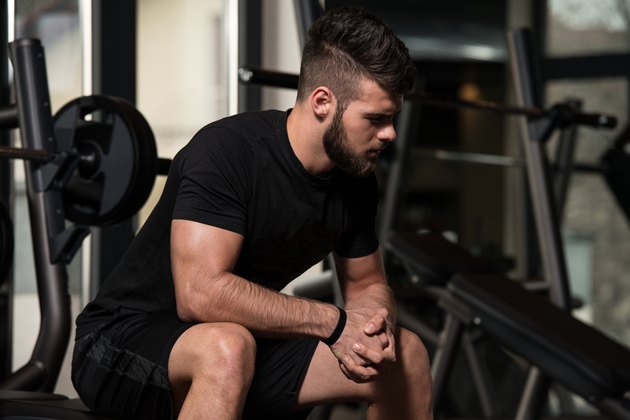Nobody enjoys injury recovery; it takes hard work and patience. Recovering from a rotator cuff tear poses challenges to strengthening the rest of your upper body. Caution is given to movements that increase the pain in your shoulder. But maintaining the muscle strength of your surrounding musculature, like the pectoral muscles, expedites your recovery process. So it's important to do both rehab and strengthening exercises. Consult your physician prior to participating in any recovery exercise program.

Advertisements
Safety First
Part of planning a safe exercise rehabilitation program is slowly progressing your goals. In the early stages of a rotator cuff injury, you must limit the movement of your shoulder to promote healing of the torn tissue. Keep in mind that this limitation doesn't deter you from pectoral muscle contractions. As you progress through exercises, be aware of whether it increases the pain in your shoulder or not. If a movement is pain-free, you can carry on. If it causes pain, modify the exercise to protect your shoulder from further injury.
Early In The Game
Immediately after a torn rotator cuff injury rest from the activity that caused it. Begin range of motion exercises during this rest period to regain your movement slowly. Your pectoralis muscles, pectoralis major and minor, function to provide shoulder and chest movement. By introducing a shoulder sawing movement, forward and backward, you are addressing the range of motion rehabilitation goal, while also contracting your pectoralis major to strengthen it. Begin in a standing position with your right elbow bent to 90 degrees and your thumb up. Slowly move your shoulder forward and back. Repeat 15 to 20 times.
Advertisements
Take a Step Forward
Progress to isometric exercises. These create a muscle contraction without movement to safely begin to strengthen the injured muscle tissue. To practice, stand in front of a door frame. Raise your right arm in front of you approximately 90 degrees, thumb up. Stand so your outstretched hand is pressed against the door frame. Add pressure into the door frame with your hand and hold for five seconds. Repeat 10 to 12 times on each side.
Persevere and Progress
Progress your exercise to combine your range of motion and strengthening achievements. Target the lower fibers of your pectoralis major and protect your shoulder from raising above 90 degrees with a decline bench press. Lie flat on your back on a declined bench at an angle between 20 and 40 degrees. Begin with just the bar for weight. Grasp the bar with an over-hand grip and at a width slightly wider than your shoulders. Push your shoulders down away from your ears and press your back into the bench. Inhale and lower the bar toward your chest. Exhale and gently straighten your elbows. Repeat eight to 10 repetitions.
Nearing Full Recovery
Nearing the end of your rehabilitation process, you can further progress your upper body strengthening. However, continue to be aware of shoulder pain. Movements like a military press, chest fly and pushup increase the strength of your shoulder, while also targeting your pectoral muscles. To practice a bench chest fly, lie on your back on a bench. With light to medium weight dumbbells in each hand, raise your arms straight so the dumbbells are in front of your eyes. Wrists facing each other. Keep a slight bend in your elbows and slowly drop each arm out to the side until it is level with the bench, no lower. Raise your arms to reunite the dumbbells. Repeat 10 to 12 times.
REFERENCES & RESOURCES Rehabilitation Techniques for Sports Medicine and Athletic Training; William E. Prentice, Ph.D. Trail Guide to the Body; Andrew Biel, L.M.P. American Council on Exercise: Decline Barbell Press



Comments